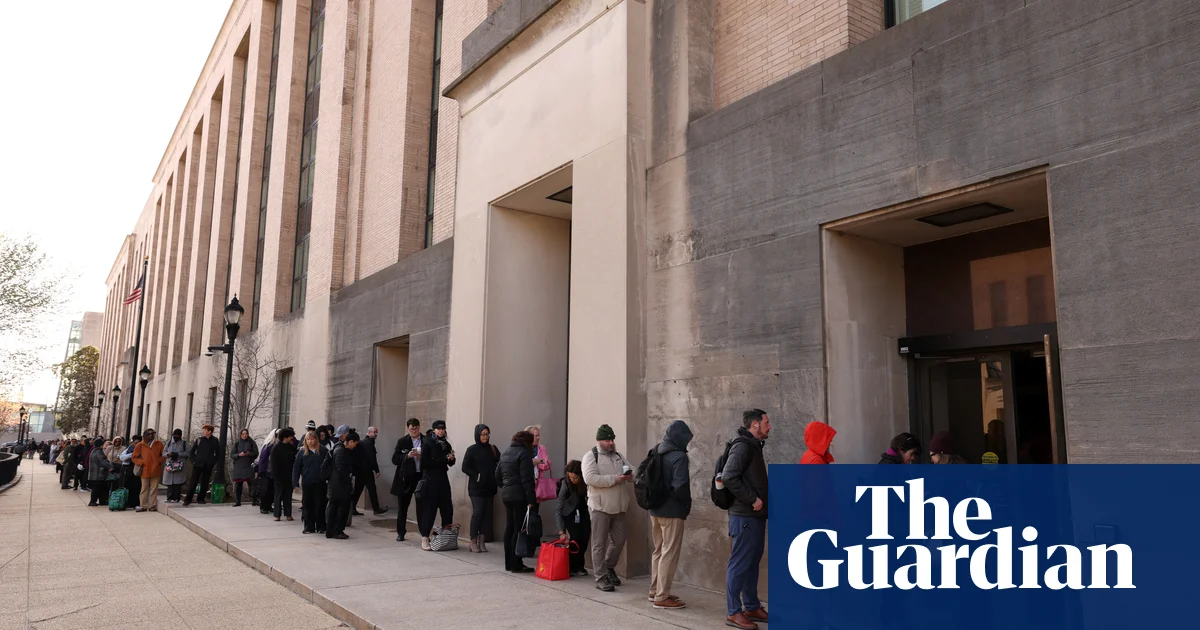From experts in mine safety to smoking and infertility – mass layoffs hit branch after branch of the Department of Health and Human Services (HHS) as part of health secretary Robert F Kennedy Jr’s plan to downsize nearly a quarter of the 82,000-person workforce took effect.
Even as the sprawling nature of layoffs became apparent on Tuesday, a complete accounting was elusive. Layoffs were undertaken with few public details, with even apoplectic congressional lawmakers left in the dark.
The result was a day of desperate crowdsourcing, as employees themselves and experts outside government became aware of programs and positions eliminated – and then processed how it would ultimately impact American lives.
Layoff notices started coming down earlier in the day, embodied by lines of staffers wrapping the sidewalk of the “Parklawn” building in Maryland – waiting to see if their badges would still work, and employees in building elevators carrying boxes of personal belongings.
But the cuts rippled out far from the DC area. In just one example in Morgantown, West Virginia, the secretary’s cuts gutted the respiratory division that protects coal miners from pneumoconiosis, a disease colloquially known as “black lung” – and one condition that has increased “astronomically” among young coal miners in Appalachia.
The cuts at HHS come alongside others to the Mine Safety and Health Administration, a separate government division that monitors mine safety conditions, housed in the Department of Labor.
“I’m not sure they realize that eliminating these jobs within [National Institute for Occupational Health and Safety] and these offices is going to affect the miners in these offices,” said Erin Bates, spokesperson for the United Mine Workers International offices.
At the Centers for Disease Control and Prevention (CDC), cuts hit an entire branch devoted to infertility – a cause that Donald Trump had championed only days earlier, calling himself the “fertilization president”.
“Following today’s layoffs at the CDC, there will be no experts on infertility who will be able to inform public policy, brief members of Congress, publish articles and reports, and advance public awareness on the causes and treatments for infertility,” Barbara Collura, president of Resolve: the National Infertility Association, said in a statement.
The loss stood alongside the CDC’s Division of Environmental Health Science and Practice (DEHSP), “slated to be eliminated in its entirety”, according to an internal email from center director Ari Bernstein obtained by POLITICO’s E&E News.
The division is responsible for preventing exposures to harmful environmental hazards and responding to climate change. It also oversees the CDC’s climate health activities and its branches on lead poisoning, asthma and air quality, water, emerging hazards, and environmental public health tracking.
Among the losses at the Food and Drug Administration (FDA) was the division devoted to crafting tobacco policy. Taxpayers will save no money – it was paid for by tobacco companies themselves.
“These cuts conflict with the repeatedly stated commitments of President Trump and Secretary Kennedy to reduce chronic disease and protect children’s health,” said Yolonda C Richardson, President and CEO of the Campaign for Tobacco-Free Kids, who said in a statement that smoking is still responsible for 30% of all cancer deaths in the US. “We cannot achieve these goals and make America healthy if our nation backs off its efforts to reduce tobacco use.”
The director of the FDA’s center for tobacco products, Brian King, told staff in an email he was placed on administrative leave the same day: “It is with a heavy heart and profound disappointment that I share I have been placed on administrative leave,” the Associated Press reported.
Meanwhile, the Administration for Community Living (ACL) at the health department was hit by significant cuts, in effect dismantling the teams focused on serving the disabled and elderly.
The Autism Society of America opposed that cut, as well as those to Samhsa (the Substance Abuse and Mental Health Services Administration) as decisions that could curtail bipartisan support for disabled Americans.
Former CDC director Dr Tom Frieden said the cuts, particularly to programs on smoking and to global health, would not “‘trim the fat’ – they will undermine our ability to prevent deaths from tobacco and disease outbreaks”.
Multiple communications teams at the FDA were also cut, including the entire media affairs division and most of the communications team of the FDA’s Center for Drug Evaluation and Research, reportedly about 50 people, sources told NBC News. This team was responsible for managing public databases on drug approvals, which includes informing the public about potential risks of FDA-approved drugs, as well as managing the drug shortages database.
Kennedy announced 10,000 jobs would be cut from the Department of Health and Human Services Thursday afternoon – offering few specifics beyond the promise that the cuts would “streamline our agency”. The cuts are compounded by losses already made by the unofficial department of government efficiency (Doge) run by billionaire Elon Musk. All told the $1.7tn health department is expected to lose up to 20,000 people, or one quarter of its 82,000-person workforce.
On Monday, nearly 2,000 members of the National Academies of Science, Engineering and Medicine issued an open letter to warn Americans of the administration’s assault on science.
As the cuts came into focus, former leaders of HHS stood in awe of their vast reach.
“The FDA as we’ve known it is finished with most of the leaders with institutional knowledge and a deep understanding of product development and safety no longer employed,” former FDA commissioner Dr Robert Califf told Mass Device, calling it, “a dark day for public health”.
